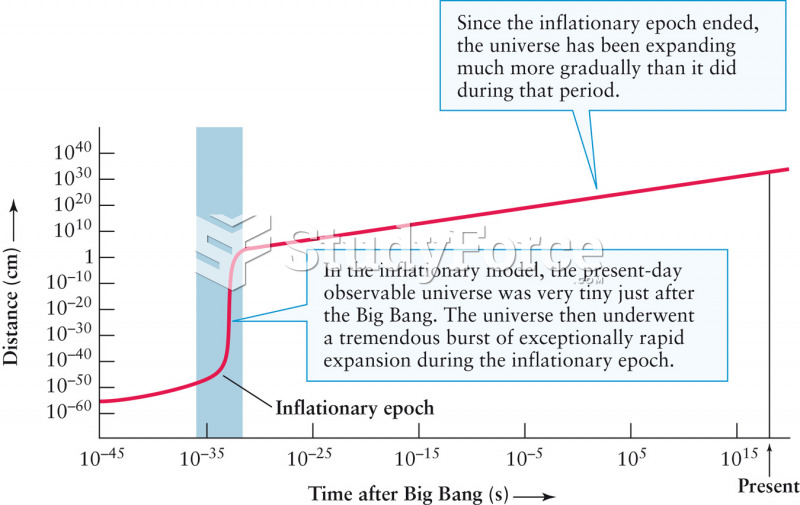Answer to Question 1
The key to the flatness problem and the horizon problem and to other problems with the simple big bang model may lie with a modified model called the inflationary big bang that predicts there was a sudden extra expansion when the Universe was very young, even more extreme than that predicted by the original big bang model. According to the inflationary Universe model, the Universe expanded and cooled until about 10-36seconds after the big bang. Then, the Universe became cool enough that the forces of nature, which at earlier extremely high temperatures would have behaved identically, began to differ from each other. Physicists calculate this would have released tremendous amounts of energy and suddenly inflated the Universe by a factor of 1050or larger. As a result, the part of the Universe that is now visible from Earth, the entire observable Universe, expanded rapidly from 1035times smaller than a proton to roughly a meter across and then continued a slower expansion to its present state.That sudden inflation can solve both the flatness problem and the horizon problem. The inflation of the Universe would have forced whatever curvature it had toward zero, just as inflating a balloon makes a small spot on its surface flatter. You now live in a Universe that has almost perfectly flat space-time geometry because of that sudden inflation long ago. In addition, because the observable part of the Universe was no larger in volume than an atom before inflation, it was small enough to have equalized its temperature by then. Now you live in a Universe that has the same cosmic microwave background temperature in all directions.
Answer to Question 2
As the young Universe expanded, it went through three important changes. First, when the Universe reached an age of roughly 50,000 years, the density of the energy present in the form of photons became less than the density of the gas. Before that time, matter could not clump together because the intense sea of photons smoothed the gas out. Once the density of the radiation fell below that of matter, the matter could begin to draw together under the influence of gravity and form the clouds that eventually became galaxy clusters and galaxies.The expansion of the Universe spread the particles of the ionized gas farther and farther apart. As the Universe reached the age of about 400,000 years, the second important change began. As the density decreased and the falling temperature of the Universe reached 3000 K, protons were able to capture and hold free electrons to form neutral hydrogen, a process called recombination. As the free electrons were gobbled up into atoms, they could no longer deflect photons. The photons could travel easily through the gas, so the gas became transparent, and the photons retained the blackbody temperature of 3000 K that the gas and photons together had at the time of recombination.Recom bination left the gas of the big bang neutral, hot, dense, and transparent. At first the Universe was filled with the glow of the hot gas, which would have been partly detectable at visible wavelengths.As the Universe expanded and cooled, the glow faded and the Universe entered what cosmologists call the dark age, a period lasting hundreds of millions of years until the formation of the first stars. During the dark age, there were no sources of visible light in the Universe.The dark age ended as the first stars began to form. The gas from which those first stars formed contained almost no metals and was consequently quite transparent. Mathematical models show that the first stars formed from this metal-poor gas would have been very massive, very luminous, and very short lived. That first burst of star formation produced enough ultraviolet light to begin ionizing the gas, and today's astronomers, looking back to the most distant visible quasars and galaxies, can see traces of that reionization of the Universe. Reionization marks the end of the dark ages and the beginning of the age of stars and galaxies that continues today.







